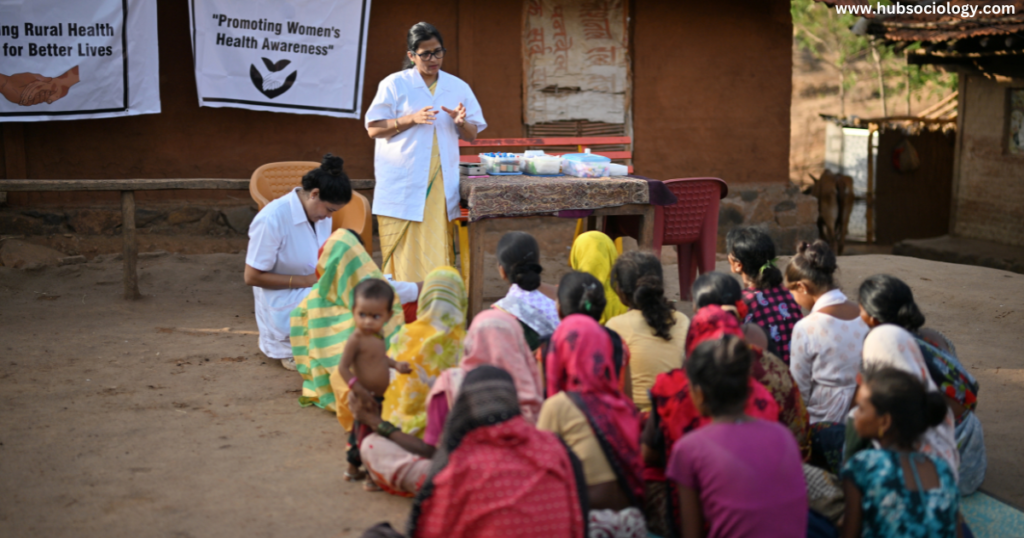Introduction on Health and Human Development

Health and human development are fundamental to sociological inquiry because they reflect the interplay between individual well-being and broader social structures. The Human Development Index (HDI), developed by the United Nations Development Programme (UNDP), provides a multidimensional assessment of development, moving beyond purely economic indicators to include health, education, and living standards. However, from a sociological perspective, the HDI and related concepts must be critically examined to understand how social inequalities, power dynamics, and institutional structures shape human well-being.
This article explores:
- The sociological understanding of health and human development
- A critical analysis of the HDI and alternative measures
- The social determinants influencing health and development
- Policy implications for equitable human development
- Future directions in measuring and promoting well-being
By integrating classical and contemporary sociological theories, this discussion highlights the need for a more inclusive and justice-oriented approach to human development.
Table of Contents
1. Health and Human Development: A Sociological Framework
A. Health Beyond Biomedicine: The Social Model of Health
The World Health Organization (WHO) defines health as “a state of complete physical, mental, and social well-being,” emphasizing that health is not merely the absence of disease but a product of social conditions. Sociologists argue that health is socially constructed and influenced by:
- Structural factors: Economic policies, healthcare systems, labor conditions
- Cultural factors: Beliefs about illness, stigma, health-seeking behaviors
- Political factors: Government policies, global health governance
Key Sociological Perspectives on Health:
- Functionalism (Talcott Parsons) – Views illness as a social role that disrupts societal functioning; healthcare systems help reintegrate individuals.
- Conflict Theory (Marxist Approach) – Argues that health disparities stem from capitalist exploitation, where the wealthy have better access to care.
- Symbolic Interactionism (Goffman, Conrad & Barker) – Examines how medical labels (e.g., “mental illness”) shape identity and social interactions.
- Feminist Theory – Highlights gendered health disparities, such as maternal mortality and medicalization of women’s bodies.
B. Human Development: Capabilities and Social Justice
Amartya Sen and Martha Nussbaum’s Capability Approach redefines development as the expansion of people’s freedoms to achieve well-being. Key principles include:
- Agency: Individuals should have control over their lives.
- Social opportunities: Access to education, healthcare, and political participation.
- Structural barriers: Poverty, discrimination, and institutionalized inequality limit development.
From a sociological standpoint, human development must address:
- Inequality (class, gender, race)
- Global power imbalances (neocolonialism in healthcare and education)
- Cultural and environmental sustainability
2. The Human Development Index (HDI): Strengths and Limitations
A. What Does the HDI Measure?
The HDI combines three dimensions:
- Health: Life expectancy at birth
- Education: Mean years of schooling and expected years of schooling
- Standard of living: GNI per capita (PPP-adjusted)
B. Sociological Critiques of the HDI
While the HDI is a significant improvement over GDP-centric models, it has limitations:
| Critique | Sociological Explanation |
|---|---|
| Oversimplifies development | Ignores inequality within countries (e.g., a high HDI can mask poverty among marginalized groups). |
| Neglects qualitative well-being | Does not account for happiness, social cohesion, or political freedoms (e.g., Saudi Arabia has a high HDI but restricts women’s rights). |
| Economic bias | GNI per capita does not reflect wealth distribution (e.g., the U.S. has high inequality despite a high HDI). |
| Lacks environmental consideration | Development that harms ecosystems (e.g., deforestation for economic growth) is not penalized. |
C. Alternative and Complementary Indices
To address these gaps, the UNDP and other institutions have developed:
- Inequality-Adjusted HDI (IHDI): Adjusts HDI based on distributional inequality.
- Gender Development Index (GDI): Compares HDI between men and women.
- Multidimensional Poverty Index (MPI): Measures overlapping deprivations in health, education, and living standards.
- Happy Planet Index (HPI): Combines well-being, life expectancy, and ecological footprint.
These indices align with sociological concerns about structural inequities and intersectionality (Crenshaw, 1989).

3. Social Determinants of Health and Development
A. Class and Economic Inequality
- Marxist Perspective: Capitalist economies create health disparities by commodifying healthcare.
- Empirical Evidence: The Whitehall Studies (Marmot, 1978) show that even among civil servants, lower-ranking employees have higher mortality rates.
B. Gender and Health Disparities
- Reproductive Health: Lack of access to maternal care in low-income nations.
- Medical Sexism: Women’s pain is often dismissed in healthcare systems (e.g., longer ER wait times for heart attacks).
C. Race, Ethnicity, and Health
- Environmental Racism: Marginalized communities face higher exposure to pollution (e.g., Flint water crisis).
- Historical Trauma: Indigenous populations suffer from poorer health due to colonization.
D. Globalization and Health Inequities
- Pharmaceutical Patents: Prevent affordable access to medicines in the Global South.
- Medical Brain Drain: Doctors from developing nations migrate to wealthier countries, exacerbating healthcare shortages.
4. Policy Implications: A Sociological Approach to Enhancing HDI
A. Universal Social Policies
- Scandinavian Model: High taxes fund robust healthcare and education, leading to high HDI rankings.
- Challenges in Developing Nations: Corruption and underfunding hinder progress (e.g., India’s under-resourced public hospitals).
B. Reducing Inequality
- Progressive Taxation: Wealth redistribution to fund social programs.
- Universal Basic Income (UBI): Experiments in Finland show improved mental health and economic security.
C. Gender-Responsive Development
- Education for Girls: Reduces child marriage and improves economic outcomes.
- Reproductive Rights: Access to contraception lowers maternal mortality.
D. Sustainable Development
- Green Social Policies: Costa Rica’s environmental policies contribute to high well-being despite modest GDP.
- Climate Justice: Poor nations bear the brunt of climate change, worsening health and development.
5. Future Directions: Rethinking Development for Social Justice
A. Decolonizing Development
- Alternative Indigenous Models: Bhutan’s Gross National Happiness (GNH) prioritizes cultural and environmental well-being.
- Post-Development Theory (Escobar, 1995): Critiques Western-centric development models.
B. Digital Inequality and Health
- Telemedicine: Can improve rural healthcare access but requires internet infrastructure.
- AI in Healthcare: Risks reinforcing biases if not ethically regulated.
C. The Role of Social Movements
- Black Lives Matter: Highlights racial disparities in health and policing.
- Feminist Health Activism: Campaigns for menstrual equity and abortion rights.
Conclusion: Towards an Equitable Future
The HDI is a valuable tool, but sociology reminds us that true development requires dismantling systemic inequities. By integrating critical theories, intersectional analysis, and participatory policymaking, we can create a development paradigm that prioritizes justice, sustainability, and human dignity.

Key Takeaways for Sociology Students:
- Health and development are socially constructed and politically contested.
- The HDI must be supplemented with inequality-sensitive measures.
- Policy must address structural barriers (capitalism, patriarchy, racism) to achieve equitable development.
Topic Related Questions on Health and Human Development
5-Mark Questions on Health and Human Development (Short Answer)
- Define the Human Development Index (HDI) and list its three key dimensions.
- How does the Capability Approach (Sen & Nussbaum) redefine human development?
- What is the main limitation of using GDP as a measure of development compared to the HDI?
- Name two alternative indices developed by the UNDP to address HDI’s shortcomings.
- How does symbolic interactionism explain the social construction of health?
- What is the “sick role” according to Talcott Parsons?
- How does feminist theory critique traditional health and development models?
- What is environmental racism? Provide one example.
- How does the Inequality-Adjusted HDI (IHDI) improve upon the traditional HDI?
- What is the Multidimensional Poverty Index (MPI)?
10-Mark Questions on Health and Human Development (Brief Essay)
- Discuss the strengths and limitations of the HDI from a sociological perspective.
- Explain how social determinants (class, gender, race) influence health outcomes.
- Compare the Marxist and functionalist perspectives on health disparities.
- How does globalization contribute to health inequities between developed and developing nations?
- Critically analyze the role of education in human development using the Capability Approach.
- Why is gender inequality a significant factor in measuring human development? Provide examples.
- How do structural barriers (e.g., capitalism, patriarchy) limit human development?
- Discuss the relationship between environmental sustainability and human development.
- Evaluate the impact of colonialism on contemporary health disparities in the Global South.
- How can social policies (e.g., universal healthcare) improve a nation’s HDI?
15-Mark Questions on Health and Human Development (Long Essay/Discussion)
- “The HDI is an incomplete measure of development.” Critically evaluate this statement using sociological theories and alternative indices.
- Analyze how power dynamics (economic, political, and social) shape global health and human development.
- Discuss the role of intersectionality (race, class, gender) in understanding health disparities, with empirical examples.
- Compare the Human Development Index (HDI) with Bhutan’s Gross National Happiness (GNH) as alternative development models.
- How can sociological perspectives contribute to more equitable health and development policies?
- Examine the impact of neoliberal economic policies on health and human development in developing countries.
- “Development must be decolonized.” Discuss this statement in the context of health and human development.
- Evaluate the effectiveness of social movements (e.g., Black Lives Matter, feminist health activism) in addressing health inequities.
- How does the digital divide reinforce inequalities in health and education?
- “True development requires addressing structural violence.” Discuss with reference to health and human development.
Additional Case-Based Questions on Health and Human Development (For Applied Learning)
- Case Study: “Sweden has a high HDI, while India ranks lower. Using sociological theories, explain the key factors behind this disparity.”
- Data Interpretation: “Given a table of HDI, IHDI, and GDI rankings, analyze which country has the most equitable development and why.”
- Policy Proposal: “Suggest three policy measures to improve India’s HDI, considering sociological barriers.”

1 thought on “Health and Human Development : Human Development Index”